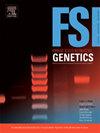来自底物的环境微生物群可能会干扰基于微生物组的法医相关体液鉴定:试点研究
IF 3.2
2区 医学
Q2 GENETICS & HEREDITY
引用次数: 0
摘要
微生物组是一种很有前途的工具,可用于鉴定沉积在犯罪现场各种基质上的体液。从犯罪现场采集的体液并非完全没有底物微生物,这些微生物对基于微生物组的体液鉴定的影响尚不十分清楚。本研究将五种体液(外周血、月经血、鼻腔分泌物、唾液和精液)放置在室内暴露条件下的无菌棉签、床单和地板上 7 天。采用针对 16S rRNA 基因 V4 区域的扩增子测序法对样本中的微生物群落进行了特征描述。结果表明,沉积在无菌拭子上的新鲜样本的微生物群落根据体液的类型而聚集在一起。沉积在床单和地板上的体液微生物群落与沉积在无菌拭子上的体液微生物群落有显著差异。模拟体液的微生物群落是纯体液微生物和环境微生物的混合物。FEAST分析表明,模拟唾液样本中的微生物主要来自纯体液(床单和地板上分别为51.53%和63.04%),而不是来自基质(床单和地板上分别为25.70%和18.92%)。在外周血、模拟鼻腔分泌物和精液样本中观察到了相反的结果。在 PCoA 可视化中,所有样本主要根据基质而非体液类型进行聚类。PERMANOVA 结果显示,基质(R2 = 0.211,P < 0.001)比体液类型(R2 = 0.152,P < 0.001)所占的变异更大。MicroDecon 用于去除模拟体液样本基质中的微生物污染。使用去污后的数据进行 PCoA 和 PERMANOVA 分析。结果表明,样本不再根据基质聚类,体液类型(R2 = 0.240,P < 0.001)比基质(R2 = 0.108,P < 0.001)更能解释样本微生物群落的变异。我们的结果表明,基质中的环境微生物群可能会干扰基于微生物组的法医相关体液鉴定。在某种程度上,净化可以减少基质对样本微生物群落的影响,提高区分体液类型的能力。这项试验研究将对促进基于微生物的染色分析在法医学中的应用具有重要价值。本文章由计算机程序翻译,如有差异,请以英文原文为准。
Environmental microbiota from substrate may interfere with microbiome-based identification of forensically relevant body fluids: A pilot study
The microbiome is a promising tool for identifying body fluids which can be deposited on various substrates at a crime scene. Body fluids collected from crime scenes are not entirely free from substrate microbes whose effects on the microbiome-based identification of body fluids are not well understood. In this study, five body fluids (peripheral blood, menstrual blood, nasal secretions, saliva, and semen) were deposited on sterile swabs, bedspreads, and floors under indoor exposure conditions for 7 days. The microbial communities in the samples were characterized using amplicon sequencing targeted V4 region of 16S rRNA gene. The results showed that the microbial communities of fresh samples deposited on sterile swabs clustered together according to the type of body fluid. The microbial composition of the body fluids deposited on the bedspread and floor is significant different from those deposited on sterile swabs. The microbial communities of mock body fluids were a mixture of microbes from pure body fluids and environmental microbes. FEAST analysis showed that the microbes of mock saliva samples were mainly from pure body fluids (51.53 % and 63.04 % on the bedspread and floor, respectively), but not from substrates (25.70 % and 18.92 % on the bedspread and floor, respectively). Contrary results were observed in peripheral blood, mock nasal secretion, and semen samples. All samples were mainly clustered based on the substrate, but not on the type of body fluid in the PCoA visualization. PERMANOVA results showed that the substrate accounted for more of the variance (R2 = 0.211, P < 0.001) than the type of body fluid (R2 = 0.152, P < 0.001). MicroDecon was used to remove contamination by microbes from the substrate of mock body fluid samples. PCoA and PERMANOVA were performed using decontaminated data. The results showed that samples were no longer clustered based on the substrate, and the type of body fluid (R2 = 0.240, P < 0.001) accounted for more of the variance in the microbial communities of samples than the substrate (R2 = 0.108, P < 0.001). Our results suggest that environmental microbiota from substrates may interfere with the microbiome-based identification of forensically relevant body fluids. To some extent, decontamination could decrease the effects of the substrate on the microbial communities of the samples and enhance the ability to distinguish between the types of body fluids. This pilot study will be valuable in promoting the application of microbiome-based stain analysis in forensics.
求助全文
通过发布文献求助,成功后即可免费获取论文全文。
去求助
来源期刊
CiteScore
7.50
自引率
32.30%
发文量
132
审稿时长
11.3 weeks
期刊介绍:
Forensic Science International: Genetics is the premier journal in the field of Forensic Genetics. This branch of Forensic Science can be defined as the application of genetics to human and non-human material (in the sense of a science with the purpose of studying inherited characteristics for the analysis of inter- and intra-specific variations in populations) for the resolution of legal conflicts.
The scope of the journal includes:
Forensic applications of human polymorphism.
Testing of paternity and other family relationships, immigration cases, typing of biological stains and tissues from criminal casework, identification of human remains by DNA testing methodologies.
Description of human polymorphisms of forensic interest, with special interest in DNA polymorphisms.
Autosomal DNA polymorphisms, mini- and microsatellites (or short tandem repeats, STRs), single nucleotide polymorphisms (SNPs), X and Y chromosome polymorphisms, mtDNA polymorphisms, and any other type of DNA variation with potential forensic applications.
Non-human DNA polymorphisms for crime scene investigation.
Population genetics of human polymorphisms of forensic interest.
Population data, especially from DNA polymorphisms of interest for the solution of forensic problems.
DNA typing methodologies and strategies.
Biostatistical methods in forensic genetics.
Evaluation of DNA evidence in forensic problems (such as paternity or immigration cases, criminal casework, identification), classical and new statistical approaches.
Standards in forensic genetics.
Recommendations of regulatory bodies concerning methods, markers, interpretation or strategies or proposals for procedural or technical standards.
Quality control.
Quality control and quality assurance strategies, proficiency testing for DNA typing methodologies.
Criminal DNA databases.
Technical, legal and statistical issues.
General ethical and legal issues related to forensic genetics.

 求助内容:
求助内容: 应助结果提醒方式:
应助结果提醒方式:


